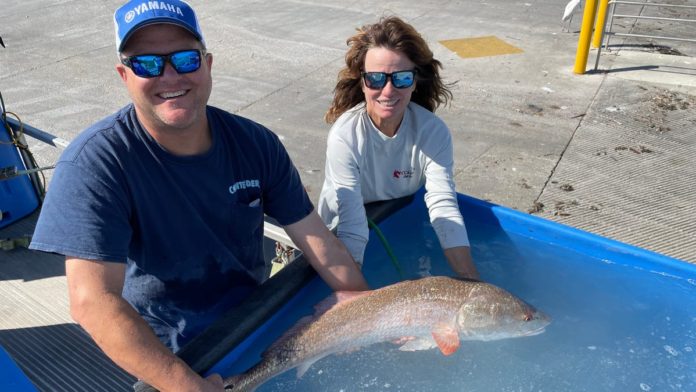Release the East: CCA Florida catches redfish brood stock
CCA Florida began its east coast redfish restocking program by catching brood stock on Oct. 18, 2021
Ed Killer, Wochit
The future of the redfish fishery on Florida’s east coast received a boost this week.
On the morning of Oct. 18, six Space Coast-area inshore fishing guides assisted the Coastal Conservation Association of Florida in capturing 10 spawning-sized redfish from the waters near Port Canaveral.
If all goes according to plan, tens of thousands of young redfish will be released back into Atlantic Coast estuaries as part of CCA Florida’s “Release the East” initiative. That could happen less than a year from now, Executive Director Brian Gorski said.
Redfish numbers lacking?: Florida redfish stocks in good shape, except in Indian River Lagoon, researchers say
Redfish workshops: Cobia, redfish workshops: Florida anglers to help set new regulations to manage catches
Goliath problems: 5 reasons lifting ban on catching goliath grouper isn’t worth it, starting with $500 fee
Duke Energy Mariculture Center will grow east coast redfish for release
The 10 redfish were captured under a Florida Fish and Wildlife Conservation Commission permit. Anglers used live baits like mullet and cut baits to catch the reds near the jetties offshore of Port Canaveral and placed them in live wells.
A chase boat carried them to a large tank on a flatbed truck. They were transported 140 miles by truck across the state to the Duke Energy Mariculture Center in Crystal River, a saltwater fish hatchery.
Before the redfish can begin to produce baby redfish, they must receive a freshwater rinse to kill any parasites the wild-caught fish may have had. That is to be followed by a 30-day quarantine, Gorski said.
“At the mariculture center, the fish will be divided into two tanks, where biologists can begin to figure out which are males and which are females,” he explained. “We know some of the 10 fish we have are males because they were drumming.”
During spawning, males attract females by vibrating a muscle in their swim bladder, which produces a drum-like noise.
The center already had three east coast redfish of spawning age: one male and two females, Gorski said. Eventually, center director Eric Lattimer’s team will combine the males and females and use a variety of techniques to manipulate the fish into spawning.
The techniques involve controlling water temperature and light to mimic the amount of daylight in a day, which enables biologists to induce the redfish to spawn several times a year instead of once a year, Gorski explained.
The small fry will be grown indoors to 1-2 inches, then transferred outdoors to 1 million gallon saltwater ponds fed by piped-in Gulf of Mexico water.
The hope is thousands of redfish, about 4-6 inches long, will be released back into the Indian River Lagoon within 8-9 months, he said. That’s when CCA Florida will work closely with many of the same fishing guides to determine ideal locations for the redfish to survive and grow into adults.
Release the East initiative fundraiser
Release the East began in 2019 with a goal of raising over $100,000 to pay for equipment, materials, fish food and more, Gorski said.
Because redfish have slight genetic differences on the east and west coasts, the mariculture center must keep the stocks apart during the growing process.
Since the center opened in 1991, it has cultivated and released over 4.1 million fish and crustaceans. The center also grows a variety of submerged aquatic vegetation from eelgrass to mangroves.
CCA Florida’s fundraising efforts were hampered by the coronavirus pandemic, Gorski said. For 15 months, the organization suspended its most effective fundraising activity: in-person auctions and banquets at state chapters across the state.
A $20,000 donation from Mudhole Custom Tackle was a much-needed kickstart to the campaign, Gorski said. Mud Hole’s pledge was to ensure 100,000 redfish will be released into the wild.
CCA Florida and Space Coast guides
Capt. Jamie Glasner of Fin & Fly Fishing Charters in Cocoa Beach assisted Gorksi in gathering guides to catch the redfish, including Troy Perez, Jon Cangianella, Travis Tanner, Rob Hollander and Mark Drown.
The time has come for the east coast redfish population to receive the same kind of boost the west coast redfish have received for years, Glasner said.
“This release program isn’t only going to help people like us who make a living off the water, but it will give the next generation of fishers the opportunity to enjoy the waters like we all did growing up,” he said. “There is still a lot of work to do with bringing the seagrass back in places like the Indian River Lagoon and Mosquito Lagoon, but this will hopefully help boost our area for a go-to inshore redfish fishery again.”
Glasner said he is happy to see CCA Florida get the program underway.
“It would be awesome if the state of Florida or FWC would implement a redfish stamp just like a snook stamp on your fishing license and allocate that money the stamp brings in to permanently fund a redfish hatchery program forever,”Glasner said. “Think of the new jobs that could create.”
The program should help east coast anglers, who’ve seen a decline in the Indian River Lagoon’s redfish population for some time, Gorski said.
“I met a man at the boat ramp as we were collecting these redfish who said inshore fishing was so poor, he sold off his inshore tackle and now strictly fishes offshore,” he said. “The east coast has been struggling with water quality issues and lack of seagrass.”
Ed Killer is TCPalm’s outdoors writer. Sign up for his and other weekly newsletters at profile.tcpalm.com/newsletters/manage. Friend Ed on Facebook at Ed Killer, follow him on Twitter @tcpalmekiller or email him at ed.killer@tcpalm.com.
Credit: Source link






























